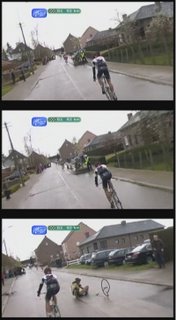Flanders and Catastrophic Wheel Failure
http://www.cycling.tv/
and watched the highlights of the tour of flanders. Oh, that's a bike race!
Anyway, during the race, I saw something I hadn't seen before - and that was a Saunier Duval rider (announcer said is was Gomez Marchante, but not sure if it was...) going au bloc with his head down and drilling a curb perpendicularly.
The resulting carnage was painful to watch - though, shockingly, it seems as if the rider made it through the ordeal in one piece.
The same couldn't be said for his wheel, nor his fork:

higher res here.
It looks like the fork legs de-bonded from the crown, eh? (Any better pictures/video on the net than the original cycling.tv stuff?) Lucky that no-one impaled themelves on those fork legs - but it's a good thing that the wheel passed the UCI safety tests, huh?
Say, in this case when the fork legs debond from the crown and the rim collapses, exposing sharp serrated edges, would this mean that the wheel fails the requirements of UCI rule 1.3.018:What is your take? It becomes hard to interpret what the "wheel" is and what the "fork" is in this case - ya know, the fork being in multiple bits and all. :-)1.3.018 :
Wheels of the bicycle may vary in diameter between 70 cm maximum
and 55 cm minimum, including the tyre. For the cyclo-cross bicycle the width
of the tyre shall not exceed 35 mm and it may not incorporate any form of
spike or stud.
For massed start road races and cyclo-cross races only wheel
designs granted prior approval by the UCI may be used. Wheels will have
minimum 12 spokes; spokes can be round, flattened or oval, asfar as no
dimension of their sections exceeds 10 mm. In order to be granted approval
wheels must have passed a rupture test as prescribed by the UCI in a
laboratory approved by the UCI. The test results must show that the rupture
characteristics obtained are compatible with those resulting from an
impact sustained during normal use of the wheel. The following criteria must be
fulfilled:
· On impact, no element of the wheel may become detached and be
expelled outwards.
· The rupture must not present any shattered or broken off elements, or any sharp or serrated surfaces that could harm the user, other riders and/or spectators.
· The rupture characteristics must not cause the hub to become separated from the rim in such a way that the wheel becomes detached from the forks.Without prejudice to the tests imposed by the laws, regulations or customs, standard (traditional) wheels are exempted from the rupture test referred to above. A traditional wheel is deemed to be a wheel with at least 16 metal spokes; the spokes may be round, flat or oval, provided that no dimension of their cross sections exceeds 2.4 mm; the section of the rim must not exceed 2.5 cm on each side.
I always kind of wondered what would be the consequences when a bike racer hit an obstacle that reproduced wheel failure modes created by the UCI safety tests. I speculated what would happen when something like this happened when I wrote the UCI and Me article for bike.com years ago.
Now, it looks like we know for sure what happens. When will we see safety tests for forks - it looks like in the Flanders incident, the fork was the weakest link - but really, would the consequences change in this instance? I reckon not - the bike is going to go flying with all of its sharp and dangerous edges, and the rider is going to hit the deck. Not much one can do when drilling a curb perpendicularly at 45-50 kph.
I've seen wheels get destroyed like what I saw on the cycling.tv footage - folded in rim, discontinous, not ridable. I saw destruction like that during my days at brand-S in the bike biz many moons ago - I reckon we catastrophically destroyed hundreds of wheels on a test fixture we nicknamed the "bonk" fixture... cuz we'd "bonk" rigidly constrained wheels with this massive pendulum.
ahh, those were the days! I get a kick out of breaking things like that. Is that normal? ;-)



0 Comments:
Post a Comment
Links to this post:
Create a Link
<< Home